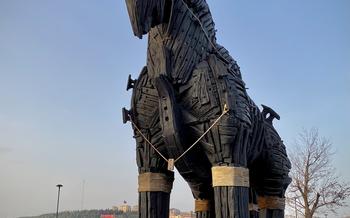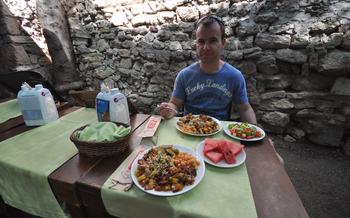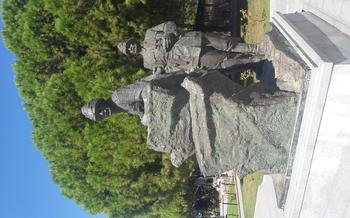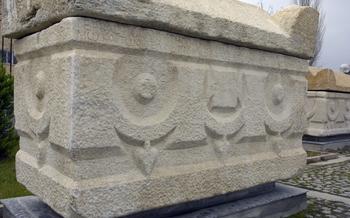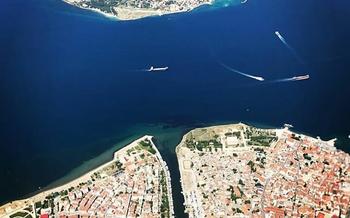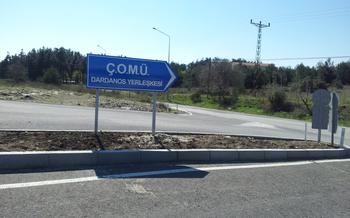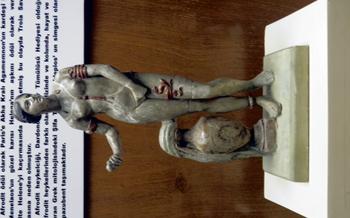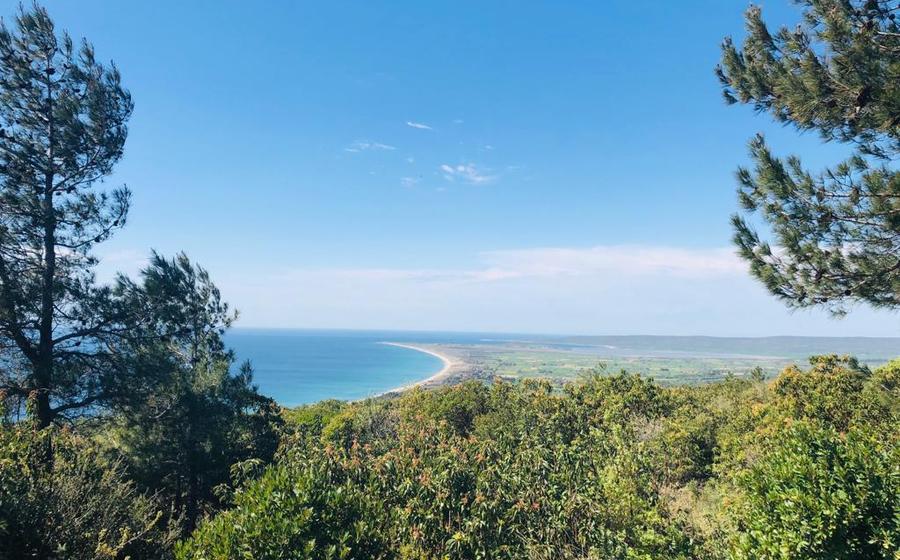
Troy (Truva) Ancient City
- History of Troy
- Location and Getting There
- Entrance Fees and Timings:
- Guided Tours
- Exploring the Archaeological Site
- Must-See Highlights
- Interactive Exhibits and Displays
- Shopping for Souvenirs
- Food and Drinks
- Nearby Attractions
- Accommodation Options
- Planning Your Visit
- Photography Tips
- Respecting the Site
- Insider Tip: Unveiling the Secret Sanctuary of Troy
History of Troy
In the realm of ancient legends, Troy stands as a timeless symbol of courage, betrayal, and the ravages of war. Immortalized by Homer's epic poem, the Iliad, Troy's tale has captivated generations with its poignant narrative of love, honor, and the clash of civilizations. Archaeological excavations conducted over the centuries have unearthed the city's rich past, revealing the existence of nine distinct layers, each representing a different era of Troy's existence. From the earliest settlements in the Bronze Age to the Hellenistic and Roman periods, Troy's ruins tell a compelling story of human ambition, conflict, and resilience.
Location and Getting There
Troy is situated in the northwestern province of Çanakkale, Turkey. It lies approximately 30 kilometers northeast of the city of Çanakkale and is easily accessible by various means of transportation. The closest airport to Troy is Çanakkale Airport (CKZ), located just 12 kilometers from the ancient city. Direct flights to Çanakkale Airport are available from Istanbul and Ankara, the two major cities in Turkey. From Çanakkale city center, you can take a bus or a taxi to reach Troy. Buses depart regularly from the Çanakkale bus station and take around 45 minutes to reach the archaeological site. Taxis are also readily available and offer a more convenient option, especially for those traveling in groups or with luggage.
Entrance Fees and Timings:
Visiting Troy requires an entrance fee that varies depending on the type of ticket purchased. The standard ticket price for adults is [indicate the current entrance fee]. Students, children, and senior citizens are eligible for discounted rates. It's advisable to check the official website or consult local tourism information centers for the most up-to-date pricing and any special offers or concessions.
Troy is generally open to the public daily, except for occasional closures for maintenance or special events. The opening hours typically range from 8:00 AM to 6:00 PM, but it's always a good idea to verify the exact timings before planning your visit.
To avoid the crowds and enjoy a more serene exploration, consider visiting Troy early in the morning or late in the afternoon. The site tends to be busiest during midday, especially during the peak tourist season. Arriving early or late will allow you to take your time exploring the ruins, capturing photos, and immersing yourself in the ancient history of Troy.
Guided Tours
Exploring Troy with a guided tour is an enriching experience that enhances your understanding of the ancient city. Professional guides offer valuable insights into the site's history, mythology, and archaeological significance. They can point out specific features and artifacts that might go unnoticed by the untrained eye. Group tours provide a social element, allowing you to share the experience with fellow travelers. Private tours, though more expensive, offer a personalized experience tailored to your interests and pace.
During my visit, I opted for a guided tour led by a passionate archaeologist. Her knowledge and enthusiasm brought the ruins to life, as she narrated the tales of Troy's legendary past. She showed us hidden details in the architecture, explained the significance of unearthed artifacts, and answered our questions with expertise. The tour made my exploration of Troy far more meaningful and memorable.
Exploring the Archaeological Site
Troy's archaeological site is a treasure trove of ancient ruins that transport visitors back in time. As you enter the sprawling site, you'll be greeted by imposing city walls that once protected the city from invaders. Explore the remains of temples, houses, and public buildings, each offering a glimpse into the daily lives of the Trojans.
The highlight of the site is the replica of the Trojan Horse, a symbol of the city's legendary downfall. Capture a photo with this iconic landmark and let your imagination run wild as you envision the epic battle that took place here.
Follow the well-marked paths that wind through the ruins, leading you to various points of interest. A map or layout of the site is available at the entrance, helping you navigate the extensive grounds.
Take your time to explore the Sanctuary, a sacred area where the Trojans worshipped their gods. Marvel at the intricate carvings and reliefs that adorn the temple walls, offering insights into the religious beliefs and practices of the ancient city.
For a deeper understanding of Troy's history and significance, consider joining a guided tour. These tours provide valuable insights and allow you to ask questions about the site's fascinating past.
Must-See Highlights
Among the many fascinating ruins and landmarks within the archaeological site of Troy, several stand out as must-see highlights for visitors. One of the most iconic is the replica of the Trojan Horse, a symbol of the legendary Trojan War. This impressive wooden structure allows visitors to step inside and experience the thrill of being part of the epic tale.
Another highlight is the Temple of Athena, a sanctuary dedicated to the goddess of wisdom and war. Its well-preserved remains offer a glimpse into the religious practices of the ancient Trojans. Visitors can admire the intricate carvings and sculptures that adorn the temple, providing insights into the artistic and cultural achievements of this ancient civilization.
Finally, the Sanctuary is a sacred area within the city walls where religious ceremonies and rituals took place. Here, visitors can explore the ruins of altars, statues, and other artifacts that shed light on the spiritual beliefs and practices of the Trojans. These highlights, along with many other fascinating discoveries, make Troy a truly captivating destination for history enthusiasts and travelers seeking an unforgettable glimpse into the past.
- Personal Recommendation: Be sure to visit the Troy Museum to gain a deeper understanding of the site's history and significance. The museum houses a collection of artifacts, including pottery, jewelry, and tools, that provide valuable insights into the daily lives of the ancient Trojans.
Interactive Exhibits and Displays
Enhancing the visitor experience at Troy is a range of interactive exhibits and displays that bring the ancient city to life. Through the clever use of technology and multimedia, visitors can delve into the captivating stories and rich history of Troy. These exhibits provide an immersive journey through time, allowing visitors to engage with the site's archaeological discoveries and gain a deeper understanding of its significance.
The Troy Museum, located within the archaeological site, houses a collection of artifacts and interactive displays that showcase the city's past. Visitors can explore replicas of ancient artifacts, such as pottery, jewelry, and tools, while learning about the daily lives of the Trojans. Interactive maps and timelines provide a visual representation of Troy's development over the centuries.
One of the highlights of the museum is a virtual reality experience that transports visitors back in time to witness the legendary Trojan War. Through the use of VR headsets, visitors can immerse themselves in the midst of the battle, experiencing the sights and sounds of the conflict. This cutting-edge technology offers a unique and unforgettable way to connect with the history of Troy.
The interactive exhibits and displays at Troy not only enhance the visitor experience but also serve as valuable educational tools. They provide a deeper understanding of the archaeological discoveries and the historical significance of the site. Whether you're a history buff, an archaeology enthusiast, or simply seeking a unique and immersive experience, Troy's interactive exhibits are sure to captivate and inspire.
Shopping for Souvenirs
After immersing yourself in the history and grandeur of Troy, you may want to take home a piece of the experience. The gift shops at the archaeological site and in the town of Çanakkale offer a variety of souvenirs to commemorate your visit.
From replica artifacts like miniature Trojan horses and pottery shards to books on the history and mythology of Troy, there's something for every budget and taste. For those looking for something truly unique, consider purchasing a handmade ceramic or glass piece inspired by ancient Trojan designs.
When shopping for souvenirs, don't forget to haggle. Bargaining is a common practice in Turkey, and you can often get a better price if you're willing to negotiate. Just be respectful and friendly, and you'll likely end up with a souvenir that you'll cherish for years to come.
Food and Drinks
After a day of exploring the ancient ruins, visitors can satisfy their hunger with delicious Turkish cuisine at nearby restaurants or cafes. The region offers a wide variety of dishes to tantalize taste buds, from traditional kebabs and pide to fresh seafood and meze platters.
For a truly authentic experience, try the local specialty, Çanakkale kebabı, a succulent lamb dish cooked in a clay pot. For seafood lovers, the grilled octopus and calamari are must-try delicacies.
For a quick bite or a refreshing break, stop by one of the cafes and indulge in Turkish coffee, a rich and aromatic brew that will energize you for the rest of your explorations.
Personal Recommendation:
I highly recommend trying the fish restaurants along the Çanakkale waterfront. The freshly caught seafood, prepared with traditional Turkish techniques, is simply divine. Enjoy your meal with a glass of local wine as you soak in the stunning views of the Dardanelles Strait.
Nearby Attractions
In addition to Troy, Çanakkale is home to other remarkable destinations that history and nature enthusiasts can explore. Here are a few suggestions:
-
Gallipoli Peninsula: Famous for the Gallipoli Campaign of World War I, this peninsula hosts several war memorials, cemeteries, and museums dedicated to the fallen soldiers. Visitors can pay their respects, learn about the historical significance, and immerse themselves in the poignant atmosphere of this battlefield.
-
Assos: An ancient Greek city located south of Çanakkale, Assos boasts well-preserved ruins, including a stunning ancient theater, a temple dedicated to Athena, and the remains of a city wall. Its charming cobblestone streets, picturesque harbor, and breathtaking views make it a delightful place to explore.
-
Bozcaada Island: This charming island in the Aegean Sea is a haven for nature lovers and those seeking a relaxing getaway. Visitors can enjoy swimming in crystal-clear waters, exploring secluded coves, and savoring delicious seafood dishes while immersing themselves in the tranquil ambiance of the island.
-
Mount Ida National Park: Located in the heart of Kaz Dağları (Mount Ida), this national park offers breathtaking landscapes, lush forests, and diverse wildlife. Visitors can embark on scenic hiking trails, admire stunning waterfalls, and encounter rare flora and fauna, making it a perfect destination for outdoor enthusiasts.
Accommodation Options
When planning your trip to Troy, a range of accommodation options are available to suit different preferences and budgets. For a comfortable and convenient stay, consider booking a hotel in Çanakkale city center. Several reputable hotels offer modern amenities, including air conditioning, Wi-Fi, and room service. These hotels often have stunning views of the Dardanelles Strait, providing a picturesque backdrop to your stay.
For a more immersive experience, opt for a guesthouse or bed and breakfast in the charming village of Tevfikiye, located just a short drive from Troy. These cozy accommodations offer a glimpse into Turkish culture and hospitality, with traditional Turkish breakfasts and warm Turkish hospitality. Some guesthouses even provide guided tours of Troy, ensuring you make the most of your visit.
If you prefer a more adventurous stay, camping sites are available near Troy, offering a unique opportunity to connect with nature and experience the tranquility of the surroundings. These campsites provide basic facilities such as showers, toilets, and cooking areas, allowing you to immerse yourself in the natural beauty of the region.
Planning Your Visit
A visit to Troy requires some planning to ensure a smooth and enjoyable experience. Here are a few tips to help you make the most of your trip:
-
Book in Advance: During peak tourist season (April-October), it's advisable to book your entrance tickets online or through a tour operator to avoid long queues. Online booking also allows you to choose a specific time slot for your visit.
-
Pack Essentials: Troy is an extensive site, so comfortable shoes are a must. Don't forget your sunscreen, sunglasses, and a hat to protect yourself from the sun. Bring plenty of water, as there are limited facilities for buying drinks within the archaeological area.
-
Plan Your Route: To optimize your time, plan your route before visiting. Decide which areas or landmarks you want to see and create an itinerary. The site map available at the entrance will help you navigate the ruins.
-
Consider the Weather: Troy is exposed to the elements, so check the weather forecast before your visit. If rain is predicted, bring an umbrella or raincoat. The site can be slippery when wet, so be cautious when walking on uneven surfaces.
Photography Tips
When visiting Troy, don't forget to bring your camera to capture the beauty and grandeur of this ancient city. The best time for photography is early morning or late afternoon when the light is soft and golden, casting a warm glow on the ruins. For stunning shots of the city walls, position yourself at a low angle to emphasize their height and majesty. To capture the intricate details of the temples and houses, use a wide-angle lens and get up close, allowing the textures and colors to come alive. Remember to bring a tripod to stabilize your camera for sharp and clear images. And if you're lucky enough to visit during the spring, don't miss the opportunity to capture the vibrant wildflowers that bloom around the site, adding a touch of color to the ancient ruins.
Respecting the Site
As you explore the ancient ruins of Troy, it's crucial to remember that you are walking on hallowed ground. This site holds immense historical and cultural significance, and it's our collective responsibility to preserve it for future generations. Please follow the designated paths and avoid touching or climbing on the ruins. Be mindful of your surroundings, and don't leave any litter behind. Remember, we are visitors in this sacred space, and it's our duty to treat it with the respect it deserves.
One personal anecdote that highlights the importance of preserving cultural heritage comes from my visit to the Acropolis in Athens. As I stood among the majestic ruins of the Parthenon, I couldn't help but feel a deep sense of awe and responsibility. I realized that these ancient monuments were not just relics of the past but living testaments to the power of human creativity and achievement. It was a profound experience that made me appreciate the importance of preserving our cultural heritage for generations to come.
Insider Tip: Unveiling the Secret Sanctuary of Troy
Beyond the bustling crowds and iconic landmarks of Troy, lies a hidden gem waiting to be discovered. Tucked away in a secluded corner of the archaeological site, the Secret Sanctuary offers a unique glimpse into the spiritual and religious beliefs of the ancient Trojans. This sacred space, believed to date back to the Bronze Age, features a series of interconnected chambers and altars, each adorned with intricate carvings and enigmatic symbols. As you step into this hidden sanctuary, you'll be transported back in time, surrounded by an aura of mystery and reverence. Take a moment to absorb the energy of this sacred place, and let your imagination wander as you ponder the rituals and ceremonies that once took place here. The Secret Sanctuary is a testament to the rich cultural and religious heritage of Troy, and a must-visit for those seeking a deeper connection to the ancient city's past.

